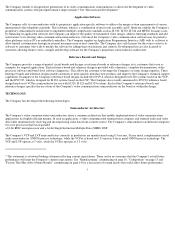8x8 1998 Annual Report Download - page 21
Download and view the complete annual report
Please find page 21 of the 1998 8x8 annual report below. You can navigate through the pages in the report by either clicking on the pages listed below, or by using the keyword search tool below to find specific information within the annual report.The Company plans to introduce additional VideoCommunicators and video communication semiconductors. The development of new
products or enhancements to existing products involves technical and other risks, which the Company may not fully understand. In addition,
new product introductions or enhancements to products may decrease demand for existing products resulting in higher than expected product
returns and/or excess inventory of existing products. The Company has in the past experienced delays in the development of new products and
the enhancement of existing products, and such delays will likely occur in the future.
If the Company is unable, due to resource constraints or technological or other reasons, to develop and introduce new or enhanced products in a
timely manner, if such new or enhanced products do not achieve sufficient market acceptance or if such new product introductions decrease
demand for existing products, it would have a material adverse effect on the Company's business and operating results.
DEPENDENCE ON PROPRIETARY TECHNOLOGY; RELIANCE ON THIRD PARTY LICENSES
The Company relies in part on trademark, copyright and trade secret law to protect its intellectual property in the United States and abroad. The
Company seeks to protect its software, documentation and other written materials under trade secret and copyright law, which afford only
limited protection. The Company also relies in part on patent law to protect its intellectual property in the United States and abroad. The
Company currently holds four United States patents, including patents relating to video compression and memory architecture technology, and
has a number of United States and foreign patent applications pending. There can be no assurance that any such patent applications will result
in an issued patent. There can be no assurance that the Company's means of protecting its proprietary rights in the United States or abroad
(where effective intellectual property protection may be unavailable or limited) will be adequate or that competitors will not independently
develop technologies that are similar or superior to the Company's technology, duplicate the Company's technology or design around any
patent of the Company. The Company has in the past licensed and in the future expects to continuing licensing its technology to others, many
of whom are located or may be located abroad. There are no assurances that such licensees will protect the Company's technology from
misappropriation. Moreover, litigation may be necessary in the future to enforce the Company's intellectual property rights, to determine the
validity and scope of the proprietary rights of others, or to defend against claims of infringement or invalidity. Such litigation could result in
substantial costs and diversion of management time and resources and could have a material adverse effect on the Company's business and
operating results.
There has been substantial litigation in the semiconductor, electronics and related industries regarding intellectual property rights, and there can
be no assurance that third parties will not claim infringement by the Company of their intellectual property rights. The Company's broad range
of technology, including systems, digital and analog circuits, software and semiconductors, increases the likelihood that third parties may claim
infringement by the Company of their intellectual property rights. If the Company were found to be infringing on the intellectual property
rights of any third party, the Company could be subject to liabilities for such infringement, which could be material, and the Company could be
required to refrain from using, manufacturing or selling certain products or using certain processes, either of which could have a material
adverse effect on the Company's business and operating results.
The Company relies upon certain technology, including hardware and software, licensed from third parties. The loss of, or inability to maintain,
existing licenses could have a material adverse effect on the Company's business and operating results.
COMPLIANCE WITH REGULATIONS AND INDUSTRY STANDARDS
The Company must comply with certain rules and regulations of the Federal Communications Commission regarding electromagnetic radiation
and standards established by Underwriters Laboratories as well as similar regulations and standards applicable in other countries. The failure of
the Company's products to comply, or delays in compliance, with the various existing and evolving government regulations and industry
17
























